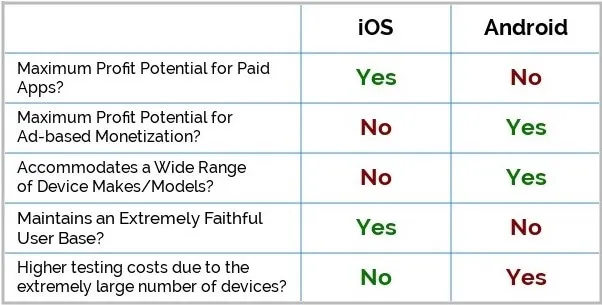You’ve finally secured app funding, but now you’re confronted with a daunting question: “Should I develop for iOS, Android, or both?” It’s an issue you hadn’t considered so, naturally, you Google it. You discover that of the 432 million smartphones sold in the fourth quarter of 2016, 77 million ran iOS, while 352 million ran Android. But you also learn that not only are Apple apps, on average, more profitable, but a recent company survey revealed that a majority of your customers prefer iOS. Now you’re completely confused!
It’s a challenge deciding between Android or iOS. And while you can develop for both, most companies don’t have the resources to develop two native apps simultaneously. Plus, even if you can develop multiple native apps at once, it’s generally not recommended because it’s far less efficient than building a single hybrid app. No matter how much time and effort you invest into preparation, a couple mistakes will inevitably reveal themselves following the app’s launch. By developing for one platform, then the other, you assume you’ll be better equipped to avoid duplicating any mistakes or oversights, resulting in a faster, more efficient build…but that’s usually not the case.
So, where do you begin? Do you develop for Android or iOS first? Should you build a hybrid app that solves for both? Or, if you’re seeking to develop just one native app, how do you pick the platform that’s best for your project and the needs of your target audience?
The Tech Perspective of Developing for iOS vs Android
The ease (or difficulty) of using various programming languages and the overall technical complexity of developing for iOS versus Android devices is somewhat subjective. Pro-Apple developers typically point to the Xcode app-building interface, which is designed to simplify and streamline the development process. So while iOS is technically more complex, the mobile app development experience tends to be easier thanks to Xcode (although the clunky build settings in the Xcode interface have attracted criticism in recent years).
By comparison, Android’s integrated development environment (IDE) has undergone some growing pains recently, as developers transitioned from the extra-glitchy Eclipse to the slightly-less-glitchy Android Studio.
As for programming languages, Apple’s iOS favors Swift, whereas Android is Java-centered. This is one area where it’s simply a matter of personal preference.
Additionally, you’ll need to consider whether there are any major upcoming operating system updates for the platform you’re considering. For instance, an iOS update that occurs mid-way through the development process will cause delays and setbacks. If you’re developing for both platforms and simply need to choose which version to tackle first, this can be a good method for making your decision. If there’s lots of buzz surrounding an iOS update in the coming 4-8 weeks, hold off on iOS and develop for Android first. Strategic timing is cost-efficient, as it prevents you from having to perform significant modifications on an application that hasn’t even been released yet.
Considering the App Stores and Competition
As you weigh whether to develop for Android vs iOS, it’s important to determine whether the app stores will serve as a primary distribution method for your app. For an enterprise app, you may simply enable downloads from a private company portal. But if you’re building a B2C app (or even a B2B app that will be widely distributed), then the app stores become significant assets. Therefore, you’ll need to evaluate the following points:
Will your app meet the app store’s development guidelines? Apple and Android apps must adhere to very precise criteria in order to be eligible for inclusion in the Google Play store or The App Store. Work with your developer to review and understand the various requirements because something as simple as the wrong type of push notifications could make your application ineligible for one or both stores.
What platform is your target audience using? Identify and then focus on developing an app for the platform that is favored amongst your target audience. If you’re focused on the wealthier, 30-something crowd, then the App Store may be your best bet, whereas if you’re aiming for an “average Joe” demographic spanning a wider age range, then developing for Android may be advisable. Ideally, you should survey your actual client or customer base to determine which type of device they use. If this is not possible, take advantage of research data in the public domain concerning the likely preference of your target demographic(s).
What platforms are your competitors using? If your primary competitors are in the Apple Store, then it may be wise to develop for iOS. Or, you could take the opposite approach and attempt to establish dominance over the unclaimed Android market segment. It’s important to note, though, that your competitors may have determined that the Android market share is too small to warrant much attention, so this is something you should research extensively before making a decision.
Which App Type Will Likely be More Profitable?
If you’re envisioning an app that would generate revenue (either with a paid app or in-app purchases), then profitability is a key consideration. The two app stores have very different cultures in terms of revenue. Paid apps tend to be more prominent for iOS, while ad-supported app models are more common for Android. Of course, supporting your app with advertisements isn’t viable (or preferable) for all companies since not every niche has loads of potential advertisers. And depending on your business type, direct profitability may not be a tremendous concern.
Historically speaking, Apple has been regarded as the more profitable app platform, with numerous studies pointing to a higher value per user (thanks in part to Apple’s loyal following). But developing for iOS may not bring higher profits if your target audience is primarily Android-based. A survey of each platform is prudent as you evaluate pricing for comparable/competing apps and the overall popularity of specific app types on each platform.
When exploring iOS vs Android, remember there is a third option: the hybrid app. Relative to native apps, hybrid applications can be far more cost-effective since you only develop one app instead of developing multiple native apps. This also results in a faster time-to-market, which is a major advantage. The drawback is that hybrid apps may be limited in their ability to leverage device-specific hardware, but this issue only impacts a portion of all mobile development projects, since custom-built native plugins can make up for any hardware specific drawbacks. Overall, hybrid apps can be an affordable, time-efficient solution for many clients, leading to a greater ROI overtime.
If you’re unsure which type of app is best for your needs, consult with an experienced mobile app development company. Dallas-based 7T works with clients throughout DFW, Houston, Austin and across the U.S. We’ve crafted a unique open source app platform called STAX which slashes development costs by as much as 35 to 40 percent. With these kinds of savings, many of our clients can develop native apps for both iOS and Android. Contact us today to learn more about what our app development team can do for your business.












